1133 Chatmoss Dr., Va. Beach, Va. 23464; (757) 495-8229
Written: 03/01/09
Many time when working on cars, we are faced with cutting metal. Sometimes for destruction: cutting a car apart, or removing a bad section of metal out. Sometimes for construction, making patch panels from sheet metal. So the question is how do I do it, or what is the best tool for the job?
Unfortunately, like most questions like this, there is NO one right answer. The answer depends on what you are trying to do. For most of our applications we wonít be cutting anything much thicker than about 1/8" steel. So the tools listed here, with the exceptions of the tin snips will do the job.
There are many tools that can be used to cut metal. Iíll try to describe the various tools for the job and their uses.
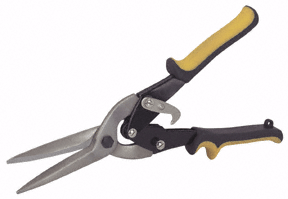 Tin snips: ($8 - $25)
Tin snips: ($8 - $25)
Tin snips (also called aviation snips) are the least expensive of all the available tools for cutting metal. In most cases these are manual, but there are some electric and air powered shears available. They are great for cutting thin sheet metal. They come in 3 types: straight, right and left curved. The curved ones are designed to help you cut a curve to either the right or left. The straight is for cutting straight lines. There is a color coding for the handles grips but it is not always followed, or the rubber grips have long since been destroyed: Red - Left cutting Green - Right cutting Yellow - Straight cutting.
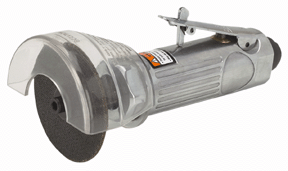 Cutoff saw ($20 - $50)
Cutoff saw ($20 - $50)
They can be either air or electric powered. The air powered cutoff tool uses a consumable cut off wheel. The cutoff saw has a clear shield to deflect the metal shavings when in use. These work for sheet metal and can be used on thicker stock but it will be slow going. It is a little difficult to control the cut and a straight line is the best cut. With some coaxing you can cut a poor curve.
I use an air powered angled die grinder with a cutoff wheel instead of the cutoff saw. Itís basically the thing, the die grinder just doesnít have the shield. So be very careful using a die grinder to cut, and wear hearing and eye protection. Iíve been cutting outside and had the wind shift and blow the grinding dust around my glasses, Iíve got to spend about an hour at the doctors with him trying to get all the metal out of my eyes. Leather work gloves wouldnít be a bad idea either as the metal can get quite hot, not to mention sharp!
There are some pros and cons to both an electric and air die grinders.
Pro: Electric - Can be carried any where - you donít need a compressor.
Pro: Air - While spinning at 10,000 rpm (no load) if they grab or jam, they stall, there isnít a lot of torque in the air turbine.
Con: Electric - if they bind and kick back, they really jump do to the inertia in the motorís armature. So be sure you hold on tight.
Con: Air - You need a compressor, and they consume a lot of air.
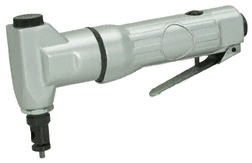 Nibblers ($20 - $850)
Either electric or air powered. These are great for cutting curves and odd shapes in sheet metal (up to about 16 gauge - just under 1/16" thick). They have a small pin that pushes the sheet metal down on a block that shears a crescent shaped piece of metal out. The work well on flat metal, but donít like metal with reinforcement ridges in them. There isnít enough clearance in the cutter to make the ramp up and down the reinforcement ribs.
Nibblers ($20 - $850)
Either electric or air powered. These are great for cutting curves and odd shapes in sheet metal (up to about 16 gauge - just under 1/16" thick). They have a small pin that pushes the sheet metal down on a block that shears a crescent shaped piece of metal out. The work well on flat metal, but donít like metal with reinforcement ridges in them. There isnít enough clearance in the cutter to make the ramp up and down the reinforcement ribs.
The only draw back to these, is the little chards of metal that it cuts. You might want to put a bucket and/or magnet below what you are cutting to collect the chards. Especially if you are working in the grass and have pets. Donít want them getting a sliver in their paw.
Rick says: ďFor nibbler check the price and availability of anvil and cutters. My Bosch nibbler costs over $100 to replace the cutter and anvil. They do break often if you are not real careful so make sure they are readily available and have a spare or 2 so you donít have to quit the job in the middle. When using a nibbler make sure you wear good shoes. Those little crescents it cuts out will work their way into your shoes and play havoc with your feet. They also will work into your soles and give your shoes ďstudsĒ which is cool for ice but hell on the kitchen floor!Ē
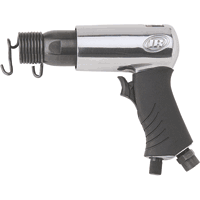 Air Chisel ($20-100)
Air Chisel ($20-100)
Another cheap tool for cutting things apart is an air chisel, around $20 with an assortment of chisels. They can come with a panel cutting blade which will take out a nice narrow strip, with little practice they work well in tight areas. The chisels are interchangeable so you can use a flat chisel to scrape stuff off or a round chisel to break stuff. I have used one to remove Quarter panels and demo a brick chimney as well so. They truly are a multi function tool, but you need an air source.
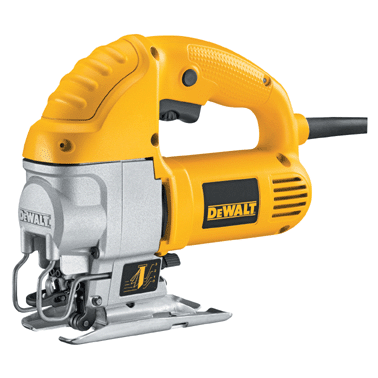 Jig/Saber saw ($30 - $300)
Jig/Saber saw ($30 - $300)
Iíve always heard these saws called saber saws. Supposedly a saber saw is a larger more powerful jig saw, but what defines the turning point? Iíve got no idea. So call them which ever you want. These are vertical reciprocating saw, the blade moves up and down. Saber saws are great for cutting thin metal and curves. If you are thinking about buying one, donít buy an inexpensive one. I purchased a re-manufactured inexpensive one several years ago to cut metal for the metal plates on the bottom of the Bricklin floor pan. After just a few minutes of cutting the saw began to smoke, I was burning it up. Iíd asked it to do more than it could, but it got me through the job.
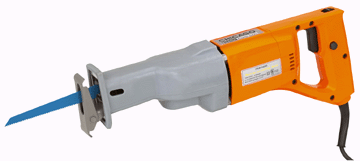 Sawzalls - horizontal reciprocating saws ($40 - $250)
Sawzalls - horizontal reciprocating saws ($40 - $250)
This is mostly a demolition tool. Not for precision cuts. They are fairly big an heavy - and actually work like any hand saw - move the blade forward and backwards across the item to be cut. I have several friends with them and they all swear by them. Weíve cut up a few cars with it.
The advantage to them is that you can change the blades and cut metal, wood, or just about anything. A long metal cutting blade can make short work of cutting through a piece of pipe or box channel. They also come in corded and cordless. They can cut metal up to say 1/2", but it will take a while.
Their disadvantage is that the blade moves in and out so you need clearance on the back of the metal. If you trying to cut off say a rear quarter panel, you may have problems because the saw will keep hitting the inner panel of the car. On thin sheet metal, the teeth can catch on the metal and pull the saw in and out instead of cutting, or push the sheet metal in and out.
But the sawzall is a great tool for a lot of jobs!
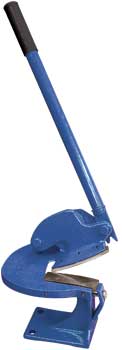
Mechanical shear - ($99 - up)
For sheet metal you can also get a small mechanical shear. There are 2 styles: one is known as a Beverly (throatless) shear, it is basically a big tin snip but can cut much thicker sheets some up to 1/4"; the second is a vertical sheer. The one I have is part of my 3 in one machine; it has sheer, bending brake, and roller so you can use the machine for more than one thing. The imports start around 300 I think. If some one is into metal work these are handy machines.
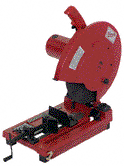 Chop Saw ($200 - up)
Chop Saw ($200 - up)
If you are cutting lots of bar, flat or tubing a chop saw (like a wood miter saw but with an abrasive blade) is the way to go for nice clean straight or angles cuts. If you buy one check blade prices and availability first, some imports use weird sized arbors and blades are hard to find. Do not get one less than 14" as you need that to cut through a 2x4 tube. As the blade wears down you can only cut smaller stock. Sometimes you have 2 or 3 blades on the go, one for small stuff that is just a old worn out blade, one for medium stuff that is mildly worn and one for big stock that is still like new. They run from around $100 to several thousand for a cold saw which uses a carbide blade with coolant.
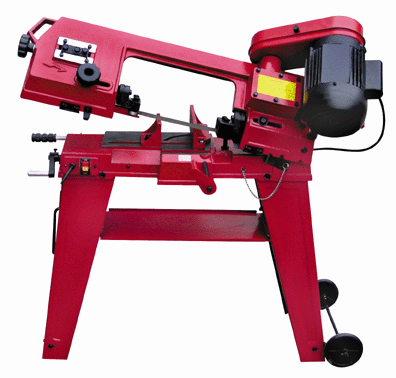 Horizontal/vertical metal cutting Bandsaw - ($200 - up)
Horizontal/vertical metal cutting Bandsaw - ($200 - up)
If youíre doing a lot of cutting bar stock, box, or pipe, even sheet metal these are fantastic. Simply slide the stock in, clamp it, turn on the saw, lower the blade, and get a cup of coffee. When you get back the cut is done and the saw is automatically turned off.
They will cut sheet metal, but they have a limited throat so the size of sheet is limited, about 12" or so.
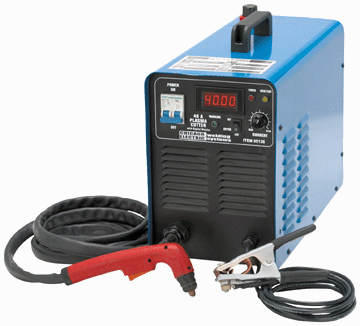 Plasma cutter ($800 - up)
Plasma cutter ($800 - up)
These are the catís meow! But if youíre trying to cut something on a car be careful as it does shower liquid metal and can start a fire. You will have to have electricity and a compressor as it uses compressed air to blow the melted metal out of the way. You will also need a set of ďgrade 4Ē welding goggles, like the ones used for an Oxy/Acetyline welder.
Rick says: ďPlasma cutters are nice but take lots of practice to make nice cuts, and the edges still need to be ground and dressed when you are done. They are quick and work in tight areas but be very careful of fires on the back side, have at least 2 working fire extinguishers at your side.Ē
Plasma cutters will cut almost anything that conducts electricity. If youíre cutting aluminum be advised that it will stay liquid longer then steel does. Consequently there is a greater possibility of getting burned.
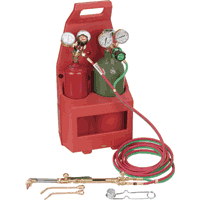 Oxy/Acetylene Torch
Finally, Iíd be remiss if I didnít mention the Oxy/Acetylene torch. You can weld and cut with this, not to mention heat metal to help bend it.
Oxy/Acetylene Torch
Finally, Iíd be remiss if I didnít mention the Oxy/Acetylene torch. You can weld and cut with this, not to mention heat metal to help bend it.
They come in different sizes from the portable one above, to the units with the large bottles on a hand truck. Which one you might want to get depends on how much you plan to use it, and if you need the portability. The problem with the small units is you will empty the gas bottles very quickly if used much. The problem with the large units are the bottles are very heavy and hard to move. But you wonít have to get them filled very often.
In closing: So like so many things, it a matter of speed, what it is your really trying to do, and what tools you have or can afford.
And remember, think safety first. Wear leather work gloves when working with metal, wear some sort of eye and hearing protection. And keep a charged fire extinguisher handy.
 Enjoy your Morgan
Enjoy your Morgan
 John
John
Return to the Index of Tech. articles
To email me with comments or questions.